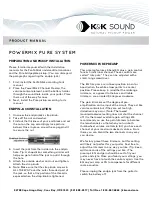
STEP 2:
Stud-mount the accelerometer to the
appropriate magnet according to the guidelines set
forth in
STEPS 2
and
3
of the Stud Mount Procedure.
STEP 3:
Prepare a smooth, flat mounting surface. A
minimum surface finish of 63 µin (0.0016 mm)
generally works best. After cleaning the surface and
checking for burrs, wipe on a light film of silicone
grease, machine oil, or similar-type coupling fluid.
STEP 4:
Mount the magnet/sensor assembly to the
prepared test surface by gently “rocking” or “sliding”
it into place. See Figure 10.
Note:
Magnetically
mounting
accelerometers
carelessly has the potential to generate very high
(and very damaging) g levels. To prevent damage,
install the assembly gently. If unsure, please contact
the factory for assistance.
4.4 HANDHELD OR PROVE TIP MOUNT
This method is NOT recommended for most
applications. It is generally used where access to
machinery may be a safety concern. Both the
accuracy and repeatability at low (<5 Hz) and high
frequency (>1 kHz) ranges are questionable.
5.0 CABLING
The selection of connectors and cables has a direct
impact on the ruggedness and reliability of the sensor
installation. A consideration when dealing with cables is
the way in which the cable conductors are terminated.
ICP® accelerometers are internally amplified, two-wire
accelerometers. Connections to the sensor require two
leads: one for the power and signal, and the other for the
common and signal return. Often, coaxial cables are used
since only two conductors are needed. Coaxial cables are
less expensive. With coaxial cables, however, erroneous
signals can be introduced into sensor systems through
ground loops, electromagnetic interference, or radio
frequency interference (EMI or RFI). To avoid ground
loops, there should only be one ground in the system.
It is recommended for permanent installations that the
sensor be case-isolated and internally shielded with a dual-
case design and use a two-conductor shielded cable to
insure clean vibration signal transmission. Two-conductor
shielded cables allow the signal and the signal return
(common) to be fully shielded from the sensor to the
readout equipment. To insure that ground loop signals are
not induced, the shield should only be terminated at one
end. Typically, the shield of a two-conductor shielded
cable is left open or not connected at the sensor end and
is tied to earth ground at the instrumentation end.
Operation over long cables may affect the frequency
response of ICP® accelerometers, and introduce low
frequency noise and high frequency distortion when an
insufficient current is available to drive cable capacitance.
Unlike charge mode systems, where the system
noise is a function of cable length, ICP® sensors
provide a high voltage, low impedance output well-
suited for driving long cables through harsh
environments. While there is virtually no increase in
noise with ICP® sensors, the capacitive loading of the
longer cable may be distort or filter higher frequency
signals depending on the supply current and the
output impedance of the sensor.
Generally, this signal distortion is not a problem with
lower frequency testing within a range up to 1,000
Hz. However, when monitoring higher frequency
vibrations traveling over cables longer than 500ft,
the possibility of signal distortion exists.
The maximum frequency that can be transmitted
over a given cable length is a function of both the
cable capacitance and the ratio of the peak signal
voltage to the current available from the signal
conditioner according to:





































